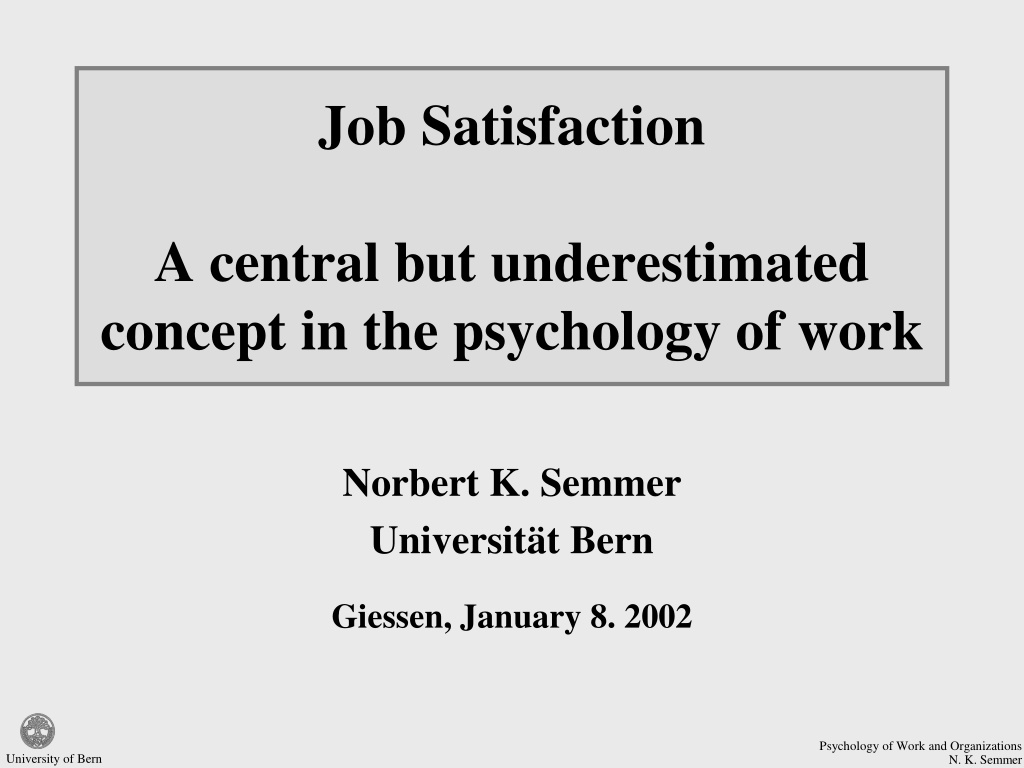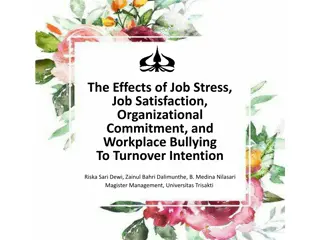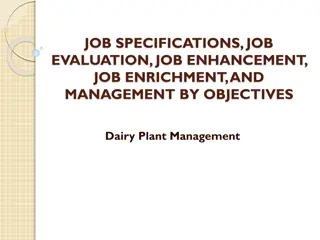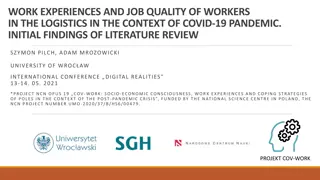Understanding Job Satisfaction in Psychology of Work: A Critical Analysis
Job satisfaction is a central yet often underestimated concept in the psychology of work. This article delves deep into the various perspectives on job satisfaction, highlighting arguments for and against its significance. From the challenges of measuring satisfaction to the influence of personality traits, it explores the multidimensional nature of job satisfaction and its implications for organizational well-being.
- Job satisfaction
- Psychology of work
- Employee well-being
- Workplace psychology
- Organizational behavior
Download Presentation

Please find below an Image/Link to download the presentation.
The content on the website is provided AS IS for your information and personal use only. It may not be sold, licensed, or shared on other websites without obtaining consent from the author. Download presentation by click this link. If you encounter any issues during the download, it is possible that the publisher has removed the file from their server.
E N D
Presentation Transcript
Job Satisfaction A central but underestimated concept in the psychology of work Norbert K. Semmer Universit t Bern Giessen, January 8. 2002 Psychology of Work and Organizations University of Bern N. K. Semmer
Job Satisfaction: A concept not highly estimated Satisfaction: ... The most superficial and ambiguous of all feelings.... Frese (1990) Frese, M. (1990). Arbeit- und Emotion Ein Essay. In F. Frei & I. Udris (Hrsg.), Das Bild der Arbeit (S. 285-301). Bern: Huber Psychology of Work and Organizations University of Bern N. K. Semmer
Job Satisfaction: A concept not highly estimated Job Satisfaction as expression of unhappiness without any aspirations Neuberger, 1980 Psychology of Work and Organizations University of Bern N. K. Semmer
Topics 1. Arguments against the concept of job satisfaction 2. Arguments against the objections 3. Job Satisfaction as result of an overall evaluation 4. Conceptionel and empirical differentiations 5. Conclusion Psychology of Work and Organizations University of Bern N. K. Semmer
Objections 1. High rates of satisfaction are not credible 2. Associations with performance are weak 3. Depends more on personality than on working conditions Psychology of Work and Organizations University of Bern N. K. Semmer
Objection 1: Unrealistically high rates of satisfaction Typically, at least 75% are satisfied (= 4 or 5 on a five-point Likert scale) Psychology of Work and Organizations University of Bern N. K. Semmer
Example: Job satisfaction of sales women 74% 20% 6% Stalder, B. (1989). Verk uferinnen: Arbeitssituation und Gesundheit. (Saleswomen: Work situation and health). Upublished Master s Thesis, Department of Psychology, Universit t Bern, Switzerland. Psychology of Work and Organizations University of Bern N. K. Semmer
High rates of satisfaction: Explanations offered People deceive the researchers (e.g., because of fear of a lack of anonymity) People deceive themselves (reduction of cognitive dissonance) It s all a meaningless ritual answers are given in accordance with social conventions ( How are you? fine, thanks... ) People have reduced their aspirations (Resignation) Psychology of Work and Organizations University of Bern N. K. Semmer
High rates are not credible: Data Questions like: Would you choose the same occupation again? or Would you recommend this profession to your son or daughter? Yield noticably lower values (about 45% yes) Psychology of Work and Organizations University of Bern N. K. Semmer
Objection 2: Negligible association with performance Meta-Analyse by Iaffaldano & Muchinsky (1985): Corrected mean correlation: r = .17 Iaffaldano, M.T., & Muchinsky, P.M. (1985). Job satisfaction and job performance: A meta-analysis. Psychological Bulletin, 97, 251-273. Psychology of Work and Organizations University of Bern N. K. Semmer
Objection 3 Characteristic of the person? Staw, Bell & Clausen (1986): Affective Dispo- sition in adolescenced and job satisfaction 50 years later: r = .34. Staw & Ross (1985): Stability between 1966 and 1971 between r = .37 and .48. Arvey et al. (1989): 30% of the variance is genetically determined (twin studies). Staw, B. M., Bell, N. E., & Clausen, J. A. (1986). The dispositional approach to job attitudes: A lifetime longitudinal test. Administrative Science Quarterly, 31, 56-77. Staw, B. M., & Ross, J. (1985). Stability in the midst of change: A dispositional approach to job attitudes. Journal of Applied Psychology, 70, 469-480. Arvey, R. D., Bouchard, T. J., Segal, N. L., & Abraham, L. M. (1989). Job satisfaction: environmental and genetic components. Journal of Applied Psychology, 74, 187- 192. Psychology of Work and Organizations University of Bern N. K. Semmer
Arguments regarding objection 1: High rates not credible? Research on general well-being yields comparably high rates (Staudinger, 2000). Argument of anonymity not convincing Older people often report better working conditions (Spector, 1997). not only resignation! Why should on deceive oneself and others regarding questions on satisfaction but not regarding questions about recommendations?? Staudinger, U.M. (2000). Viele Gr nde sprechen dagegen, und trotzdem geht es vielen Menschen gut: Das Paradox des subjektiven Wohlbefindens. Psychologische Rundschau, 51 185-197. Spector, P.E. (1997). Job satisfaction: Application, assessment, cause, and consequences. London: Sage. Psychology of Work and Organizations University of Bern N. K. Semmer
Arguments concerning objection 2: Association with performance negligible? Iaffaldano & Muchinsky (1985): Corrected correlation over all studies: r = .17 But: Studies using well established instruments concerning overall satisfaction (e.g, DI / MSQ): r = .29 Petty et al. (1984): .31 Judge et al. (2001): .30 Iaffaldano, M.T., & Muchinsky, P.M. (1985). Job satisfaction and job performance: A meta-analysis. Psychological Bulletin, 97, 251-273. Petty, M.M., McGee, G.W., & Cavender, J.W. (1984). A meta-analysis of the relationships between individual job satisfaction and individual performance. Academy of Management Review, 9, 712-721. Judge, T.A., Thoresen, C.J., Bono, J.E., & Patton, G.K. (2001). The job satisfaction-job performance relationship: A qualitative and quantitative review. Psychological Bulletin, 127, 376-407 Psychology of Work and Organizations University of Bern N. K. Semmer
Arguments concerning objection 3: Reflecting only disposition? Elfering, Semmer & K lin, 2000: Stability of job satisfaction over one year: .32 For Stayers : .41 For Leavers : .29 Controlling for personality characteristics: Hardly any change in stability (stayers: .43; leavers: .23) Stabilities for personality characteristics noticibly higher: r = .60 (Agreeableness) to .79 (Extraversion) Dormann & Zapf (2000): Partialing out working conditions reduces stability of job satisfaction to zero. Elfering, A., Semmer, N. & K lin, W (2000). Stability and change in job satisfaction at the transition from vocational training into real work . Swiss Journal of Psychology, 59, 256-271. Dormann, C. & Zapf, D. (2001). Job satisfaction: A meta-analysis of stabilities. Journal of Organizational Behavior, 22, 483-504. Psychology of Work and Organizations University of Bern N. K. Semmer
Conceptual issues: Definitions Job satisfaction as a pleasurable or positive emotional state resulting from the appraisal of one s job or job experiences (Locke, 1976) versus Job satisfaction as Attitude (involving the weighting of pro s and con s) e.g. Spector (1997) Locke, E. A. (1976). The nature and causes of job satisfaction. In M. D. Dunnette (Ed.), Handbook of Industrial and Organizational Psychology (pp. 1297-1350). Chicago, IL: Rand McNally (p. 1300). Spector, P.E. (1997). Job satisfaction: Application, assessment, cause, and consequences. London: Sage. Psychology of Work and Organizations University of Bern N. K. Semmer
Job Satisfaction and turnover within one year (voluntary quitting in per cent) (Computer specialists - Baillod & Semmer, 1994) 60 r = .37 47.8 50 Freiwillige K ndigung (%) 40 30 25.9 20 13.7 10 6.5 Baillod, J. & Semmer, N. (1994). Fluktuation und Be- rufsverl ufe bei Computer- fachleuten (Turonver and professional careers among computer specialists). Zeitschrift f r Arbeits- und Organisationspsychologie, 38, 152-163. n = 143 n = 134 n = 153 n = 139 0 "++" "+" "-" "--" General Job Satisfaction (Quartiles) Psychology of Work and Organizations University of Bern N. K. Semmer
Job Satisfaction and Turnover (Computer Specialists) stay-stay (n=272) stay-leave (n=40) 4.5 4.5 4 4 3.5 3.5 3 3 2.5 2.5 t1 t2 t3 t1 t2 t3 leave-leave (n=40) leave-stay (n=73) 4.5 4.5 4 4 3.5 3.5 3 3 2.5 2.5 t1 t2 t3 t1 t2 t3 Semmer, N. & Schallberger, U. (1996).Selection, Socialization, and mutual adaptation: Resolving discrepancies between people and their work. "Applied Psychology": An International Review,45, 263-288. Psychology of Work and Organizations University of Bern N. K. Semmer
Turnover and the Development of Job Satisfaction among Computer Specialists 4.5 4.0 3.5 3.0 2.5 2.0 mehr als 1 Jahr vor Wechsel before the change weniger als 1 Jahr vor Wechsel before the change weniger als 1 Jahr nach Wechsel after the change mehr als 1 Jahr nach Wechsel after the change more than a year before the change more than a year less than a year less than a year more than a year Unternehmenswechsel Stadler, R. (1994). Berufliche Ver nderungen bei Computerfachleuten (Career changes among computer specialists). Unpublished Master s Thesis, University of Bern, Switzerland. Psychology of Work and Organizations University of Bern N. K. Semmer
General Job Satisfaction and Turnover Fig. 3 .71 .74 .72 .82 .89 .84 .33 .36 GJS 1 GJS 2 GJS 3 .41 .43 .35 -.32 .30 -.39 .10 .15 .67 .70 .76 TURN 12 TURN 23 .13 .39 .34 .22 .24 .53 .60 COM 1 COM 2 COM 3 .79 .71 .84 .81 .88 .85 .90 .90 .88 .90 .84 Chi2 = 195.36, df = 112, p =.00, rmr = .03, gfi = .94, agfi = .92, aic = 277.36 Semmer, N.K:, Grob, A. Elfering, A. & Baillod, J. (2001). Job satisfaction and organizational commitment as predictors and conse- quences of turnover: A three-wave investigation Unpublished manuscript, University of Bern, Dept. of Psychology, Bern, Switzerland Psychology of Work and Organizations University of Bern N. K. Semmer
Predicting voluntary turnover for different motivations to quit Push Motivation Pull Motivation .46/.54 .32/.48 GJS GJS+1 .61/.65 GJS GJS+1 .54/.43 .30/.29 .50/.55 -.53/-.46 0.0 0.0 .28/.21 .72/.76 .71/.76 .70/.73 .80/.76 TURN TURN .51/.48 .24/.40 .13/.35 .00/.02 .49/.43 .47/.76 COM COM+1 .71/.77 COM COM+1 .64/.78 Semmer, N.K:, Grob, A. Elfering, A. & Baillod, J. (2001). Job satisfaction and organizational commitment as predictors and consequences of turnover: A three-wave investigation Unpublished manuscript, University of Bern, Dept. of Psychology, Bern, Switzerland Psychology of Work and Organizations University of Bern N. K. Semmer
Changes in Job Satisfaction Fig. 5 General Job Satisfaction 5.0 Leavers (Pull) Stayers 4.5 4.0 3.5 3.0 Leavers (Others) Leavers (Push) 2.5 2.0 Time 1 Time 2 Time 3 Semmer, N.K:, Grob, A. Elfering, A. & Baillod, J. (2001). Job satisfaction and organizational commitment as predictors and consequences of turnover: A three-wave investigation Unpublished manuscript, University of Bern, Dept. of Psychology, Bern, Switzerland Psychology of Work and Organizations University of Bern N. K. Semmer
Forms of Job Satisfaction (Bruggemann, 1974) COMPARISON: perceived reality - personal goals Stabilising SATISFACTION Diffuse DISSATISFACTION Raising of Standards Keeping of Standards Lowering of Standards Keeping of Standards Resignative Job Satisfaction No Problem- Solving Attempts Problem- Solving Attempts Distortion of Reality Progressive Job Satisfaction Stabilized Job Satisfaction Pseudo Job Satisfaction Fixated Job Dissatisfaction Constructive Job Dissatisfaction After Bruggemann, A. (1974). Zur Unterscheidung verschiedener Formen von "Arbeitszufriedenheit" (Distinguishing different forms of job satisfaction). Arbeit und Leistung, 28, 281-284. Psychology of Work and Organizations University of Bern N. K. Semmer
Resigned attitude towards work (after Oegerli, 1984) My work is not ideal but after all, it could be worse Quitting my job would imply even more disadvantages; so I stay in spite of all It is best to swallow one s anger when bothered by something at work As an employee one really cannot expect a lot Oegerli, K. (1984). Arbeitszufriedenheit: Versuch einer qualitativen Bestimmung. Unver fftl. Dissertation, Universit t Bern, Philosophisch-historische Fakult t. Psychology of Work and Organizations University of Bern N. K. Semmer
Job satisfaction and resignation in four samples Comp Arch Sales Secr 3.50 (.94) 4.15 (.90) 4.18 (.65) 4.12 (1.04) General job satisfaction 1.85 (.79) 1.87 (1.02) 3.28 (.79) 2.27 (1.14) Resignation Comp = Computer scientists (Baillod, 1994) Arch = Architects (unpublished data, University of Bern, Dept. of Psychology Sales = Saleswomen (Stalder, 1989) Secr = Secretaries (Ruch, 1985) Baillod, J. (1992). Fluktuation bei Computerfachleuten (Turnover among computer specialists). Bern: Lang. Ruch, L. (1985). Strukturvergleich im Sekretariatsbereich (A comparison or working structures among secretaries). Unpublished Master's Thesis, University of Bern, Department of Psychology. Stalder, B. (1989). Verk uferinnen: Arbeitssituation und Gesundheit. (Saleswomen: Work situation and health). Upublished Master s Thesis, Department of Psychology, Universit t Bern, Switzerland. Psychology of Work and Organizations University of Bern N. K. Semmer
Forms of job satisfaction & Health Complaints (Saleswomen) 3 2.59 2.59 2.44 2.5 health complaints 1.94 2 1.5 1 0.5 0 Sat- Res- Sat- Res+ Sat+ Res- Sat+ Res+ Forms of job satisfaction Sat+/Res- significantly different from all other groups Stalder, B. (1989). Verk uferinnen: Arbeitssituation und Gesundheit. (Saleswomen: Work situation and health). Upublished Master s Thesis, Department of Psychology, Universit t Bern, Switzerland. Psychology of Work and Organizations University of Bern N. K. Semmer
Forms of Job Satisfaction & Intention to Quit (Computer Specialists) 3.64 3.64 4 3.5 health complaints 3 2.51 2.5 2.12 2 1.5 1 0.5 0 Sat- Res- Sat- Res+ Sat+ Res- Sat+ Res+ Forms of job satisfaction Sat+/Res- significantly different from all other groups Baillod, J. (1992). Fluktuation bei Computerfachleuten (Turnover among computer specialists). Bern: Lang. Psychology of Work and Organizations University of Bern N. K. Semmer
Forms of job satisfaction and well-being: Irritation among job beginners (Young Workers from five occupations, t1) MEAN Irritation 5,00 4,00 * ** 3,48 3,37 3,00 3,12 3,02 2,00 1,00 Sat-/Res- Sat-/Res+ Sat+/Res- Sat+/Res+ t1: Forms of Job Satisfaction (N=1356) Unpublished data, Aequas-Study, University of Bern, Psychology of Work and Organizations Psychology of Work and Organizations University of Bern N. K. Semmer
Forms of job satisfaction and well-being: Irritation among job beginners (Young Workers from five occupations, t2) 3.74 3.8 3.7 health complaints 3.6 p < .10 3.5 3.33 3.4 3.3 3.16 3.12 3.2 3.1 3 2.9 2.8 Sat- Res- Sat- Res+ Sat+ Res- Sat+ Res+ Forms of job satisfaction t2, n = 632 Unpublished data, Aequas-Study, University of Bern, Psychology of Work and Organizations Psychology of Work and Organizations University of Bern N. K. Semmer
General Job Satisfaction and resigned attitude towards work: Associations with third variables Job Resignation satisfaction - .37* Intention to quit (Computer specialists) .27* Health complaints (salespeople) Back pain (Secretaries) -.31* .45* -.14 .23* Psychology of Work and Organizations University of Bern N. K. Semmer
Resigned attitude and unwinding: Changes inadrenalin in the evening compared to the end of work (in per cent) 15 12 10 health complaints 3 5 0 -5 -10 -15 -16 -17 Res - -20 Res - Forms of job satisfaction Res + Res + t1 t2 Aequas sub-project Bern, unpublished data Psychology of Work and Organizations University of Bern N. K. Semmer























